The Pinniped Rehabilitation Pathway: From Rescue to Release at CWC
Read this pictorial story about the rescue and release of a malnourished California Sea Lion pup found on a busy beach
Read this pictorial story about the rescue and release of a malnourished California Sea Lion pup found on a busy beach
By: Cambria Wells, Education and Outreach Manager
At CWC we treasure our opportunity to undo some of the damage inflicted on our patients by human impact. The experience of working directly with wildlife and acting as a positive influence on the course of their future is a privilege limited to a few, and as our core mission that carries us forward. But there’s an open secret in our field; we wish our patients had never been forced to need our help to begin with. In our interactions with our community, we focus every day on educating others about how to keep wildlife safe. This year, we’re expanding our capacity to share what we know and love with the ten million people who reside in the areas we serve. The new CWC education program is an all-ages outreach effort centered on what wildlife rehabilitation is, how it is practiced, and how to live alongside wildlife as a good neighbor. Our van, funded through generous donations from (now retired) Los Angeles County Supervisor Sheila Kuehl, will travel Southern California to offer free educational outreach opportunities. We come to you excited to share exhibits, crafts, activities and presentations based around human/wildlife conflict principles and California’s Next Generation Science Standards. Topics include:
… And more! Activities range from simple talks to multi-station workshops, and start at the pre-k level. We believe everyone has something to learn from wildlife; we learn something new every day!
We are now scheduling events for our 2024 pilot year and have special flexibility and capacity as the program grows. Schools, businesses, and events are encouraged to fill out a program request form at cawildlife.org/education

New Education Vanimal
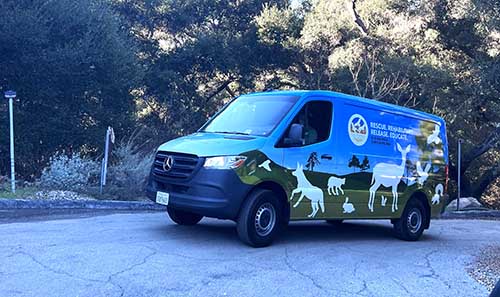
Cambria in Education vehicle
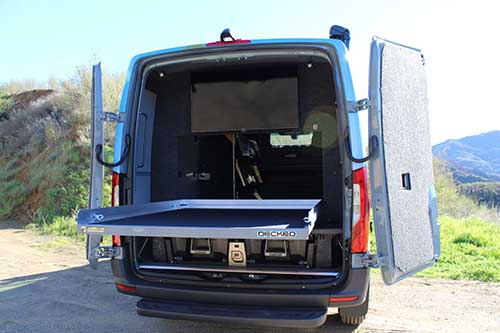
Back of vehicle
By: Dr. Guthrum Purdin, Veterinarian
The animals who are brought to wildlife rehabilitation centers represent a myriad of species, each having unique biological and behavioral needs. Successfully treating an animal who may have been dying when they arrived requires a deep understanding of what that particular individual needs, and how their condition is affected by species-specific variables. Very little medical research has been done on treating wildlife, so rehabilitators need to make themselves keen observers and experts on the animals they handle. Often, new therapies and treatment strategies are created by individuals working in the terra incognita of wild animal care.
Many years ago, when my wife and I were finishing our undergraduate classes prior to attending veterinary school, we were co-directors of animal care here at the California Wildlife Center, just a few years after it first opened. I remember one case from this period that needed us to be especially creative in order to help a female Mallard who arrived in dire condition.
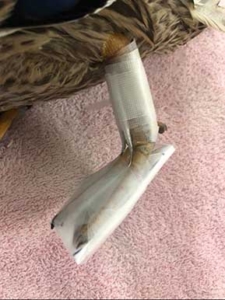
Duck boot – photo credit by Dr. Rebecca Duerr
The Mallard had been seen by a regular dog & cat veterinary office for an injured leg before transfer to CWC. That vet had put a splint on the leg that would have been fine for a dog, but the duck was having a lot of trouble. On arrival, she was tumbling over & over as she tried to stand, failed, fell over, and panicked again and again. We removed the leg wrap and found a bone called the tarsometatarsus (TMT) was broken very close to the foot. This bone is below the hock (the hock is the joint equivalent to a human ankle but looks like a backward facing knee when ducks are waddling around). It’s normal for mammals to include the joints above and below a bone fracture into a splint to stabilize the break. However, with most birds, such wraps make normal walking impossible and wild animals quickly start to panic. Plus, birds will heal fractures quicker, with less risk to surrounding joints, if they can use the leg normally. For a broken TMT, we usually apply stiff padded splints to one or two sides of the bone. This can be enough for a hawk or a songbird. For this duck, it was not enough— she was folding the foot under the leg, standing with her foot upside down. We had to put our thinking caps on for this one! The solution we came up with was to make a “shoe” of stiff material (like the firm closed-cell foam used in certain food packaging) cut in the shape of the foot, padded, and taped on, plus we cut metal paperclips, bending them to match the angle of the TMT where it meets the foot, wrapped them in padding, and taped the whole rig in place. Voila! The first “duck boot” was made. The female Mallard could now put her weight comfortably on the leg, walking easily and confidently—without panicking.

Duck boot splint – photo credit by Dr. Guthrum Purdin
But wait! I didn’t mention she had ducklings with her. A broken leg like hers usually means the bird is “dry docked” for a while, kept out of water so the splint and wrap can stay dry. But with her babies in tow, she would need to be able to get into and out of a shallow pool of water. The answer was using a kind of plastic tape that maintained its stickiness in the water, giving her a waterproof boot. With a good diet, medication for pain and inflammation, plus a quiet, peaceful enclosure to heal in, this Mallard was able to resolve the fracture, take care of her ducklings, and they were all released together back into the wild.
Since then, we’ve used this splint dozens of times, taught its use at rehabilitation conferences and veterinary schools, and it has been included in a couple textbooks. This is not a unique story. Wildlife rehabilitators, from highly trained veterinarians to deeply committed volunteers with no formal education, have come up with many of the crucial treatment modalities used around the world for countless injured, sick, and orphaned wild animals who, without their caregiver’s dedication and determination, would not have survived. These techniques are shared and refined amidst the rehabilitation community and will benefit distressed wild animals for generations to come. Every time I go to a conference, open a journal, or sit down to dinner with a colleague, I never know what new ideas and innovations will be revealed!
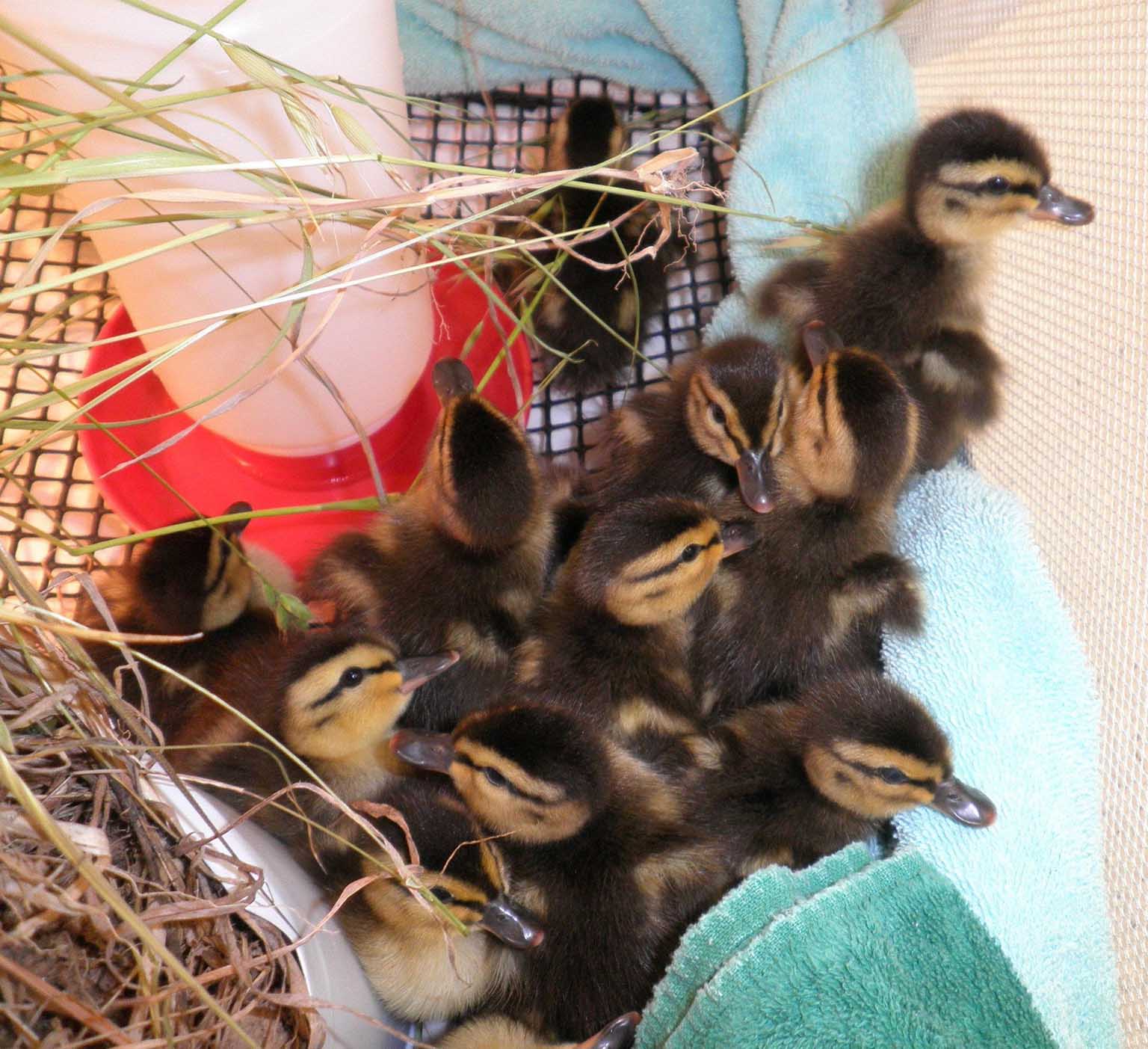
Ducklings – photo credit by Dr. Guthrum Purdin
By: Jasmine Regaldo, Volunteer Coordinator
This season California Wildlife Center participated in 14 outreach events! These were a combination of educational presentations for schools and clubs, partnering with other non-profits, and hosting educational and interactive booths at events open to the public. As CWC is not open to the public or able to provide tours to school groups or camps, one of the most effective ways that we can increase exposure for the organization is to be present in the communities that we serve.
These in-person educational booths have fun animal related activities for children but also real feathers from previous patients, skull replicas of marine mammals, and cast moldings of the footprints of terrestrial mammals. For many folks, this is their first time seeing any of these items and being able to physically touch or hold them. For children and adults alike, the excitement and awe are unparalleled when they feel the softness of a Great Horned Owl Feather, see the vibrant rust color of the Red-Tailed Hawk tail feathers, compare their hands to the paw prints of a coyote or skunk, or hold a replica skull of an adult California Sea Lion or Bottlenose Dolphin for the first time. The more exposure and education the public has to these magnificent native species, the more likely they are to care about their wellbeing in the future and become their advocate.
In 2023 alone CWC has participated in events in in Agoura Hills, Chatsworth, Simi Valley, Macarthur Park, Calabasas, Lake Balboa, Sherman Oaks, Glendora, Malibu, Thousand Oaks, Watts, and Burbank. This is only a fraction of the myriad of communities and smaller neighborhoods that comprise L.A. County, but these are 11 more cities with people who may not have known about CWC prior to the event they attended. The people we contacted are now equipped with more knowledge on California native animal species and can share that information and knowledge with others in the community. In total our outreach education and activities reached 1400 people.
We look forward to being able to reach even more members of the community in 2024!

Staff & Volunteers at Outreach event

Outreach Setup

Volunteer Coordinator, Jasmine at Outreach event
By Jenn Guess, Hospital Manager
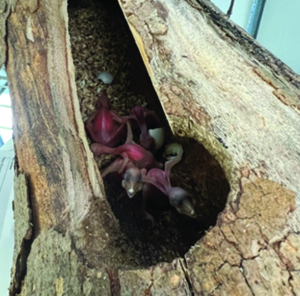
Hatchling Acorn Woodpeckers admitted to CWC after branch was trimmed from tree
Trees are essential to our environment in many ways. They absorb and store carbon dioxide, which helps mitigate climate change by reducing greenhouse gases, and are a primary source of oxygen production. Roots help bind the soil preventing erosion, and some varieties of trees even improve soil by making it more fertile for plant growth. One of the most important aspects of trees is their role in supporting wildlife by providing habitat, food, shelter, and nesting sites for a wide variety of species. For example, Acorn Woodpeckers excavate nesting cavities in trees to raise their young and reuse these nest holes for many years. Western Gray Squirrels build compact ball-shaped nests on sturdy branches high in the trees, typically in the canopy. Hummingbirds are known for their tiny and intricate nests made from plant material and spider webs. These golf ball sized creations can be found in well-concealed spots in trees and shrubs.
At CWC we recommend planting native plants to help support wildlife in your neighborhood. In the wild, vegetation is only limited by resources and each species’ genetics. When trees grow near human development, trimming and maintenance is often needed to keep plants healthy and man made structures safe.
Tree trimming serves several vital purposes, making it an essential aspect of tree care. It removes excessive dead branches, allowing the tree to allocate nutrients towards growth. Trimming also removes diseased limbs, which prevents the spread of infection and promotes overall tree health. Overgrown branches can also pose a significant risk to people and property, but regular trimming ensures that branches do not grow too close to buildings, power lines, or roadways.
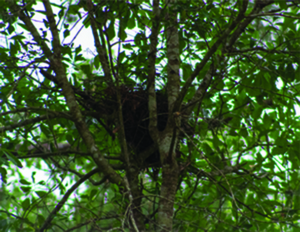
Tree squirrel nest in tree
Selecting the appropriate time of year to trim trees is critical for protecting native wildlife. Here at CWC we often see the detrimental aftermath of tree trimming gone wrong. Each spring, summer, and fall we admit hundreds of orphaned animals due to people cutting down and/or destroying nests. Tree trimmers can also permanently scare away bird parents if they disturb or linger around a nest for too long. December is the ideal month to trim because many tree species are dormant, they lack leaves allowing for a clearer view of the tree’s structure, and it is the time of year in which it is least likely to disturb an active nest. Most birds tend to nest between February and August, although some species like hummingbirds, doves, and pigeons have been known to nest year-round in Southern California. Tree squirrels can mate twice a year and usually have active nests between January through April and July through October. Historically these time frames were more consistent but shifts in climate conditions have made these nesting periods slightly unpredictable.
Before starting a tree trimming project, it is always advisable to consult a local wildlife expert, arborist, and/or conservation organization to understand the specific needs of the wildlife in the area. Prior to trimming, inspect the tree carefully for active nests. Young animals will often become quiet and stay still if they feel threatened, so using binoculars to examine each branch for movement or activity can be helpful. Look on the ground below the tree for a collection of fresh bird droppings. This can signal that a nest above might be inhabited. If possible, trim branches by hand so it is easier to see up close what is being removed. Only trim branches that are necessary for safety and tree health and leave as much natural habitat as possible, including cavities and foliage. Dead branches also provide important habitats for a number of insect and bird species. Consider leaving some deadwood on trees if it does not pose a safety risk.
Through responsible tree trimming, it is possible to safely enjoy healthy plants while simultaneously protecting the habitats that so many wild animals need in order to thrive in the wild.
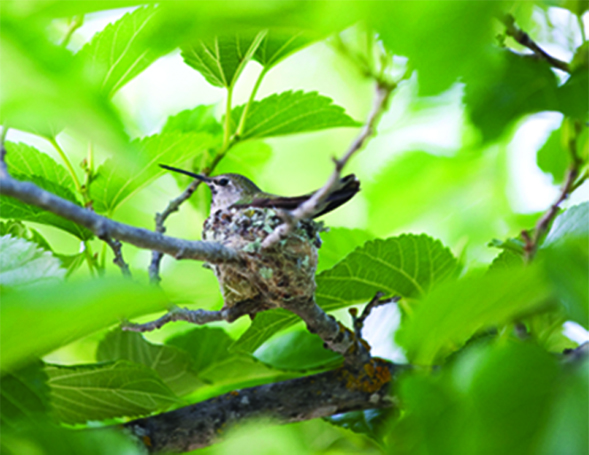
Anna’s Hummingbird nest in a tree
By Jasmine Regalado, Volunteer Coordinator
With a small staff and 4,300 patients admitted each year, it quickly becomes obvious how important volunteers are to California Wildlife Center (CWC). Volunteers may be the first point of contact for members of the public, rescuers on the beaches of Malibu, line cooks preparing a multitude of diets, or nurses helping to medicate patients. CWC volunteers are a group of passionate and extremely generous folks who make our facility run on all cylinders.
Our volunteers commit to a shift of four hours per week, on the same day and time every week, for a minimum of six months. This allows for consistency with their assigned team and ensures there is always coverage to care for our patients. We are incredibly lucky to have such committed folks—some of whom have been with us for over 10 years! There are a multitude of reasons why our volunteers choose CWC to donate their time to, but every single one of them is passionate about wildlife rehabilitation and conservation.
Each animal that arrives at CWC is received by a volunteer, examined by our hospital staff then cared for by staff and volunteers until they are ready for release. This can take anywhere from just a couple of weeks if the patient is an adult bird with minor injuries, to several months if they are an orphan or juvenile. Regardless of the time any animal spends at CWC, their well-being is of the utmost importance to us. Every patient receives the highest standard of rehabilitative care. Most of the patients require handfeeding and each will spend some time inside, which means that their enclosures must be changed out daily (at a minimum), and once outside volunteers assist with setting up enclosures to represent the outside world and to care for the patients as they prepare for release. For the 150+ species of animal, each needs a different diet based on their species and age—and those diets are meticulously created by our volunteers! Last year, our volunteers donated over 28,000 hours—incredible work by a group of 240 people.
Simply put, we would not be able to operate without the help of the extremely generous volunteers that donate their time, expertise, and passion for wildlife. We recognize and appreciate our volunteers and are incredibly lucky to have them work beside us. human caused, so it’s only fair that there exists some human interference to try and repair some of the damage.
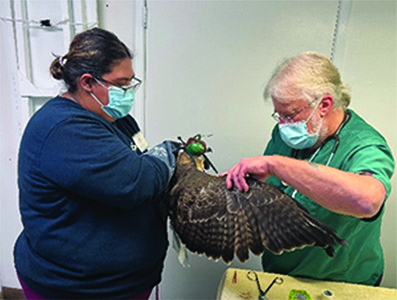
Vet Volunteer Griselda assisting Dr. Purdin with hawk examination
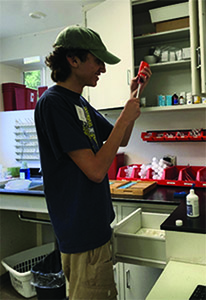
Intern Austin prepares medication for patients
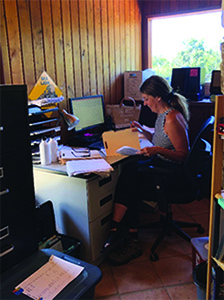
Volunteer Susan assisting with administrative work

Interns Natalie & Harleen preparing hawks for transfer
All of us here at California Wildlife Center are constantly advocating for native wildlife. Whether it’s on the phone with one of the tens of thousands of calls we receive each year or answering questions from our friends and families about their wildlife encounters, we do our best to support animals through education. One person at a time, we explain why that fledgling bird is okay to leave alone or why those raccoons are hanging out in your yard.
Harbor seals are found in nearly every ocean across the globe. There are even two local sites in Malibu that support year-round populations, and yet our Marine Mammal Rescue Team receives only one or two reports per year about a harbor seal in distress. How can this be? Pacific harbor seals (Phoca vitulina) are very shy and go to great lengths to keep their distance from humans.
A Southern California Edison biologist brought a rare patient to California Wildlife Center (CWC) this March – a young native Pocket Mouse. This small mammal can be found in chaparral and grasslands from the San Francisco Bay area to Baja California. Brownish gray in color with white bellies, large ears and hind feet, the mouse has a distinctive fur-tipped tail.
By Jennifer Brent, Executive Director
As we head into winter and say good-bye to 2022, I’d like to take a moment to thank you for supporting our work. The last two years have been exceptionally difficult for us as well as for many of you. However, 2022 also brought a return to CWC of our valuable volunteers, many of whom were on hiatus during the peak of the pandemic. We have nearly 200 people who give their time to help the animals and donate over 25,000 hours annually.
And we definitely needed them! In the past 12 months we have received over 4,100 animals in peril. Whether suffering from rodenticide poisoning, trapped in a glue trap, struck by a car, flown into a window, pet caught or orphaned, we have seen a wide range of reasons for intake. It’s important to note that the vast majority of animals that we see are here as a result of humans. Birds don’t fly into trees, but they perceive glass as clear and certainly fly into windows at full force. Foxes don’t run into cars, but when roads are built where animals traditionally crossed for ages, they’re struck by tons of speeding metal.
That’s why we especially appreciate you! The enlightened supporters who recognize that these animals are worth saving! While other people see a hurt bird and say, “oh, it’s just another dove” you say “I can help that bird!” You drive from Lancaster to bring us a baby squirrel that fell from a tree or from Downey with a Band-tailed pigeon. You read our social media posts and ask us how YOU can take action and rid your neighborhood of the ominous black poison traps. You slow down to allow a skunk to cross and you use bird tape to save lives.
Thank you for every step you take to make a difference for animals.
P.O. Box 2022
Malibu, CA 90265
Hotline Phone: +1 310 458-WILD (9453)
E-mail: admin@cawildlife.org
Enter your email address for the chance to win a private tour of CWC
Your information will never be shared with a third party
